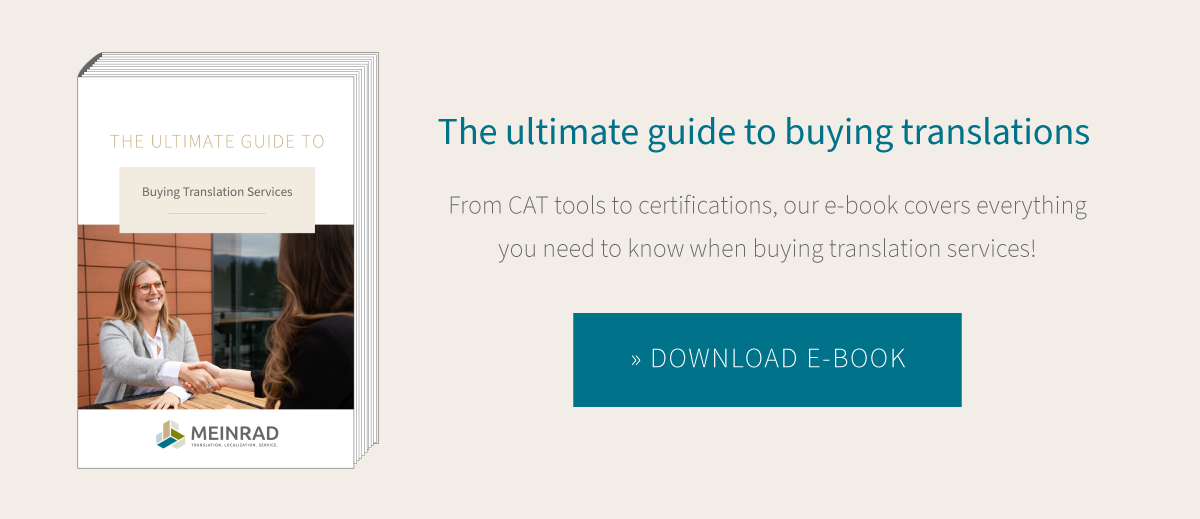
The old legal principle that “Ignorance is no excuse” applies as much in Austria as it does everywhere else. So it’s worth reading our interview with Jörg Ertelt, founder and owner of HELPDESIGN ∙ JÖRG ERTELT. As an expert in technical and electronic documentation, he knows what to look out for from a legal perspective when buying translation services and who is liable in a worst-case scenario.
Generally speaking, what role does product liability play when buying translations?
When buying translations, you sow the seed that can, if the worst comes to the worst, lead to claims for damages. In most cases, the claims will be made against the manufacturer of the product: manufacturers are liable for their products if they have defects which have led to personal injury, for instance. Other causes of personal damage (e.g. death, injuries or damage to health) can be informational defects, which can come from texts such as the instructions for a machine. If we assume that the original instructions did not contain any informational defects, the defects could have arisen from the translation. It could simply be a matter of having chosen a translator who’s cheap, but can’t tell whether the text is talking about a crane for lifting things or the long-legged bird. It’s not a case of “buying cheaper increases your profit” here – it’s more like “buying the right translation services decreases your product liability”. So you shouldn’t leave choosing a translator to your Purchasing department, because they’re usually not familiar with translation issues.
Lots of products have CE marking. What does it mean?
The 2016 Blue Guide on the implementation of EU product rules contains the following information: “By affixing the CE marking to a product, the manufacturer declares on his sole responsibility that the product is in conformity with the essential requirements of the applicable Union harmonisation legislation providing for its affixing and that the relevant conformity assessment procedures have been fulfilled. Products bearing the CE marking are presumed to be in compliance with the applicable Union harmonisation legislation and hence benefit from free circulation in the European Market.”
What does translation mean for CE marking?
Translation is extremely important when it comes to CE marking. The CE marking may only be applied to a product subject to CE marking regulations if the requirements for CE marking have been met, and one of the many requirements is that the user information be available in the language of the country in which the product is placed on the market. So if, for example, a manufacturer wishes to place a product on the market in Greece, the user information must be available in Greek. If this manufacturer produced the user information in English, it will need to be translated. Only then is this CE marking requirement met.
Which languages does technical documentation need to be translated into?
If the technical documentation is product instructions for technical products, in principle the documentation must be translated into the language of the country in which the product is placed on the market.
What happens if a country has more than one official language, such as Finland, Belgium, Malta, Cyprus or Ireland?
In that case, it depends on which harmonization legislation with mandatory CE marking applies to the product. If the product is a machine, Annex I, Section 1.7.4 of the machinery directive 2006/42/EC (“Instructions”) is clear: “All machinery must be accompanied by instructions in the official Community language or languages of the Member State in which it is placed on the market and/or put into service.”
“Language or languages” means, for example, that instructions for a machine to be placed on the market in Belgium, with its three official languages, should in principle be translated into three languages: French, Dutch and German. But in reality, that may not be necessary. Section 246 (“The official languages of the EU”) of the Guide to Application of the Machinery Directive relaxes this regulation: “Certain of the Member States with two or more official languages (e.g. Belgium, Finland) accept the use of one language only in areas where only that language is spoken. Manufacturers are advised to check this with the national authorities concerned. Other Member States with two official languages (Malta and Ireland) accept the sole use of English.”
So manufacturers placing machines on the market in Belgium or Finland are well advised to contact the national authorities concerned. If the authorities give the green light to monolingual instructions, manufacturers don’t have to translate their instructions into the other official languages. But manufacturers and customers hoping to make private law arrangements with the aim of eliminating this language problem shouldn’t get their hopes up: contractual rights do not take precedence over public law.
Who is responsible for providing a translation?
All economic actors (manufacturers, importers, distributors and agents) are responsible for providing product user information in the language of the country in which the product is placed on the market.

The aim of this legislation is to ensure that, if one or more economic actors do not meet this requirement, other economic actors can ensure this requirement is met. So if (for example) the product manufacturer does not supply any user information, the importer or distributor must step in. The importer and distributor have the option to refrain from placing the product on the market if they do not wish to produce any user information, or to produce user information at their own expense – in the correct language, of course.
Who is liable for errors in technical documentation?
In principle, the product manufacturer is liable – but not solely – for errors in technical documentation. A typical example of technical documentation is the instructions for a machine. If these instructions are not available, incomplete, incorrect or not translated into the relevant language, the machine (!) is defective. In Austria and Germany, this is due to the Austrian Product Liability Act (PHG) and the German Product Liability Act (ProdHaftG) respectively. These acts inextricably link products with the associated user information by establishing that a product is defective if it does not ensure the safety which could reasonably be expected when taking all circumstances into account, e.g. with regard to the presentation of the product. Here, “presentation” means the instructions. If the instructions do not meet safety requirements as far as can reasonably be expected, the product, in this case the machine, is defective.
Both the PHG and the ProdHaftG make manufacturers liable for damage, e.g. death, injury or damage to health, caused by a defective product. They are the national implementations of the European directive 85/374/EEC concerning liability for defective products.
Who can be made liable for translation errors?
The answer to this follows on from the previous question. If the instructions for a machine contain translation errors which mean that the machine does not meet safety requirements as far as can reasonably be expected, in the event of damage the machine manufacturer can be made liable – though not solely – as a result of this inextricable link between the product and its user information.
But of course this doesn’t mean translators can deliver any old rubbish and put their feet up. Although they will initially be left unscathed in the event of damage, as the injured party is not normally told who did the translation, the manufacturer will in all probability do everything they can to seek redress for the damages they may have had to pay the injured party. And the manufacturer has the option to seek this redress from their translation service provider.


